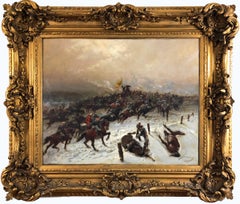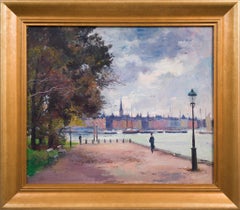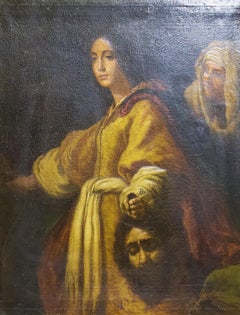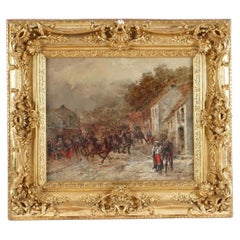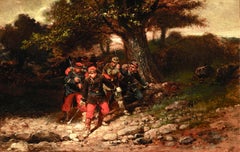Wilfrid-Constant Beauquesne Art
French, 1847-1913
Wilfrid-Constant Beauquesne was born in Rennes on October 28, 1847, and died at Montgeron on October 9, 1913. He is a French painter. He was a pupil of Horace Vernet and Émile Vernet-Lecomte at the École des Beaux-Arts in Paris. A painter of military scenes, he is mainly known for his paintings on the Franco-German War of 1870. We also owe him the decoration of the chapel of Château de Vincennes.
to
3
3
3
1
1
Men Fraternizing with Ladies, Pre-20th Cen Oil Painting by Wilfrid Beauquesne
By Wilfrid Constant Beauquesne
Located in Long Island City, NY
Artist: Wilfrid Constant Beauquesne, French (1840 - 1913)
Title: Men Fraternizing with the Ladies
Year: c. 1890
Medium: Oil on Canvas, signed l.l.
Size: 21.5 x 26 in. (54.61 x 66.04 ...
Category
1890s Old Masters Wilfrid-Constant Beauquesne Art
Materials
Canvas, Oil
Antique French Oil Painting Army Cavarly Soldier Horse Military Despatch Bearer
By Wilfrid Constant Beauquesne
Located in Portland, OR
A fine antique oil painting by Wilfred Constant Beauquesne (1847-1913), of a French cavalry soldier on horseback, 1883.
The painting titled "The Despatch Bearer", depicts a French cavalry soldier riding his horse frantically to deliver despatches to the front. The soldier in full uniform with his cavalry trooper's sword hanging from his sadle & the horse hair from his Cuirassier helmet...
Category
1880s Impressionist Wilfrid-Constant Beauquesne Art
Materials
Oil, Panel
Franco-Prussian Battle Scene
By Wilfrid Constant Beauquesne
Located in Missouri, MO
Wilfrid Constant Beauquesne (1847 - 1913)
"Franco-Prussian Battle Scene" c. 1900
Oil on Canvas
Signed Lower Right
Site Size: approx 22 x 28 inches
Framed Size: approx 35 x 40 inches
French artistry was deeply influenced by three wars during the 19th century and, accordingly, the artistic imagination was not lost upon the public. "Patriotism comes to the aid of battle painters," a contemporary remarked, "presenting them with a sympathetic public already fascinated by the subject." After the brief Franco-Prussian conflict of 1870, French painters were particularly anxious to retrieve national pride by presenting works which reflected their own national heroism versus enemy brutality.
Known for his scenic depictions of this war, Wilfried Beauquesne, a native of Rennes, France, was undoubtedly influenced in his selection of subjects by his instructors at the Ecole des Beaux Arts in Paris. Vernet-Lecomte and Horace Vernet were both well known military artists. Vernet had actually lived and worked during the period of Napoleonic conflicts - being awarded the Legion of Honor by the Emperor's own hand. Beauquesne exhibited regularly at the annual Paris Salon between 1887 and 1899, as well as throughout Europe.
In 1890, illustrating the fortunes of life, The Art Amateur ran the following item in its "Gossip Column:"
"A queer story comes to me from Paris. A commission agent made a bargain with a poor painter, living out at Saint-Maude, to paint military subjects for him, at two francs an hour. The agent changed the signature to that of Gaubault, and sold the pictures to various dealers. On day, by chance, the poor painter came to Paris, went to the Salon, and was astonished to see one of his pictures there. He look at the catalogue, and found the name of the artist and the address of the dealer where he was to be found, The poor artist went to the dealer and introduced himself saying, "I am Gaubault." "Most happy to make your acquaintance," replied the dealer. "Your pictures sell very well, and I have been wanting to see you for the last six years." "But my name is not Gaubault, it is Beauquesne." Explanations followed. The dishonest commission agent disappeared; and Beauquesne restored his real signature on the pictures, which had made his pseudonym almost famous...
Category
Late 19th Century Impressionist Wilfrid-Constant Beauquesne Art
Materials
Canvas, Oil
Price Upon Request
Related Items
Impressionistic View over Strandvägen, Stockholm
Located in Stockholm, SE
This painting by Bernhard Oscarsson (1894-1977) is a captivating visual narrative of Stockholm's serene beauty. Oscarsson, a student of Caleb Althin's painting school and the Royal S...
Category
1930s Impressionist Wilfrid-Constant Beauquesne Art
Materials
Canvas, Oil
Judith with the Head of Holofernes, Antique Oil Painting after Cristofano Allori
By Alessandro di Cristofano Allori
Located in Berlin, DE
Judith with the head of Holofernes, antique oil painting after Cristofano Allori.
Painting has been restored.
Dimensions without f...
Category
18th Century Old Masters Wilfrid-Constant Beauquesne Art
Materials
Canvas, Oil
$6,608 Sale Price
20% Off
H 35.44 in W 27.56 in
Resting Boats oil on canvas painting spanish mediterranean seascape
Located in Sitges, Barcelona
Title: Resting Boats
Artist: Enric Beltrán Messa (1940–2006)
Technique: Oil on canvas
Dimensions: 15 x 18.1 in
Support: Canvas, unframed
Signature: Signed in the lower right corner
P...
Category
1970s Impressionist Wilfrid-Constant Beauquesne Art
Materials
Oil, Canvas
$472 Sale Price
33% Off
H 14.97 in W 18.12 in
17th century follower of Rubens, two military men on horse back in a landscape
Located in Woodbury, CT
17th century English/Dutch School, from the Circle of Sir Peter Paul Rubens
A very interesting and well-painted 17th-century oil on canvas of two men seated on horseback in a landsc...
Category
1680s Old Masters Wilfrid-Constant Beauquesne Art
Materials
Canvas, Oil
$8,050 Sale Price
30% Off
H 16 in W 22 in
J. Clays (British painter) - 19th century Still Life painting - Fruits
Located in Varmo, IT
J. Clays (British, 19th-20th century) - Still life with fruit basket.
61 x 51 cm without frame, 67.5 x 58 cm with frame.
Antique oil painting on canvas, in a gilded wooden frame.
...
Category
Late 19th Century Old Masters Wilfrid-Constant Beauquesne Art
Materials
Oil, Canvas
$588 Sale Price
50% Off
H 26.58 in W 22.84 in
Impressionist Painting of a Riverscape, The Bridge at Argenteuil. Oil on Canvas.
By (after) Claude Monet
Located in Cotignac, FR
Impressionist view of a river landscape, oil on canvas board.
A charming Impressionist scene of people enjoying the delights of the riverbank. Some strolling, others enjoying a picn...
Category
Late 20th Century Impressionist Wilfrid-Constant Beauquesne Art
Materials
Oil, Canvas, Board
$490 Sale Price
20% Off
H 14.97 in W 21.66 in
Religious Italian painter - 18th century figure painting - Saint Monica prayer
Located in Varmo, IT
Italian painter (18th century) - Saint Monica in prayer.
56 x 32 cm.
Antique oil painting on canvas, without frame (not signed).
Condition report: Good state of conservation of th...
Category
Mid-18th Century Old Masters Wilfrid-Constant Beauquesne Art
Materials
Oil, Canvas
$944 Sale Price
55% Off
H 22.05 in W 12.6 in
Antique Roman painter - 18th century landscape painting - Wanderers - Italy
Located in Varmo, IT
Roman painter (18th century) - Landscape with Wayfarers.
43.5 x 34.5 cm unframed, 58.5 x 49.5 cm with frame.
Ancient oil painting on canvas, in a carved and gilded wooden frame (no...
Category
Early 18th Century Old Masters Wilfrid-Constant Beauquesne Art
Materials
Canvas, Oil
$1,176 Sale Price
44% Off
H 23.04 in W 19.49 in
Antique Italian painter - 18th century figure painting
Located in Varmo, IT
Italian painter (18th century) - Chrono.
90.5 x 106 cm.
Antique oil painting on canvas, without frame (not signed).
Condition report: Lined canvas. Good state of conservation of t...
Category
Early 18th Century Old Masters Wilfrid-Constant Beauquesne Art
Materials
Canvas, Oil
$4,706 Sale Price
20% Off
H 35.63 in W 41.74 in
Interior with woman oil on canvas painting
Located in Sitges, Barcelona
Luis Giner Bueno - Interior with woman - Oil on canvas
Oil measurements 27x41 cm.
Frame measurements 50x64 cm.
Giner Bueno (1935-2000)
Painter from Alicante, son of the painter L...
Category
1980s Impressionist Wilfrid-Constant Beauquesne Art
Materials
Canvas, Oil
18th-Century Spanish School, Child Jesus Embracing The Cross
Located in Cheltenham, GB
This early 18th-century Spanish oil painting depicts an infant Jesus clutching a cross before a landscape.
Dressed in a flowing white robe, as a symbolic reference to purity, the ch...
Category
Early 18th Century Old Masters Wilfrid-Constant Beauquesne Art
Materials
Oil, Canvas
19th Century English Antique, Two Country farmers drinking beer in a landscape
By George Morland
Located in Woodbury, CT
Attributed to George Morland.
19th Century English Antique, Two Country farmers drinking beer in a landscape.
Wonderful early 19th-century original oil on canvas.
A classic 'Morland' composition as the painter was a big fan of English Pub scenes...
Category
Early 1800s Old Masters Wilfrid-Constant Beauquesne Art
Materials
Canvas, Oil
$3,160 Sale Price
20% Off
H 20 in W 16 in
Previously Available Items
French Cavalry Franco-Prussian War Oil Painting Circa 1880
By Wilfrid Constant Beauquesne
Located in New York, NY
Oil painting by Wilfrid Constant Beauquesne (1847-1913) depicting the French cavalry in the street of Saint-Privat following the battle held outside the town during the Franco-Prussi...
Category
19th Century French Belle Époque Antique Wilfrid-Constant Beauquesne Art
Materials
Canvas
Ready for Battle
By Wilfrid Constant Beauquesne
Located in New Orleans, LA
This poignant oil was composed by Wilfrid Constant Beauquesne, a French artist renowned for his scenes of Frenchmen on the battlefield. He was heavily influenced by the French milita...
Category
19th Century Academic Wilfrid-Constant Beauquesne Art
Materials
Canvas, Oil
French Painting Signed Wilfried Constant Beauquesne
By Wilfrid Constant Beauquesne
Located in Roma, IT
Oil on canvas painting depicting several figures demonstrating in the square. A beautiful gold frame completes the work. Very good condition. It comes from a Dutch private collection...
Category
Late 19th Century French Napoleon III Antique Wilfrid-Constant Beauquesne Art
Materials
Canvas, Giltwood
Wilfrid Constant Beauquesne art for sale on 1stDibs.
Find a wide variety of authentic Wilfrid Constant Beauquesne art available for sale on 1stDibs. You can also browse by medium to find art by Wilfrid Constant Beauquesne in canvas, fabric, oil paint and more. Much of the original work by this artist or collective was created during the 19th century and is mostly associated with the Old Masters style. Not every interior allows for large Wilfrid Constant Beauquesne art, so small editions measuring 31 inches across are available. Customers who are interested in this artist might also find the work of Henri Edmond Cross, Jean-Baptiste-Antoine Guillemet, and Maximilien Luce. Wilfrid Constant Beauquesne art prices can differ depending upon medium, time period and other attributes. On 1stDibs, the price for these items starts at $6,000 and tops out at $6,000, while the average work can sell for $6,000.

